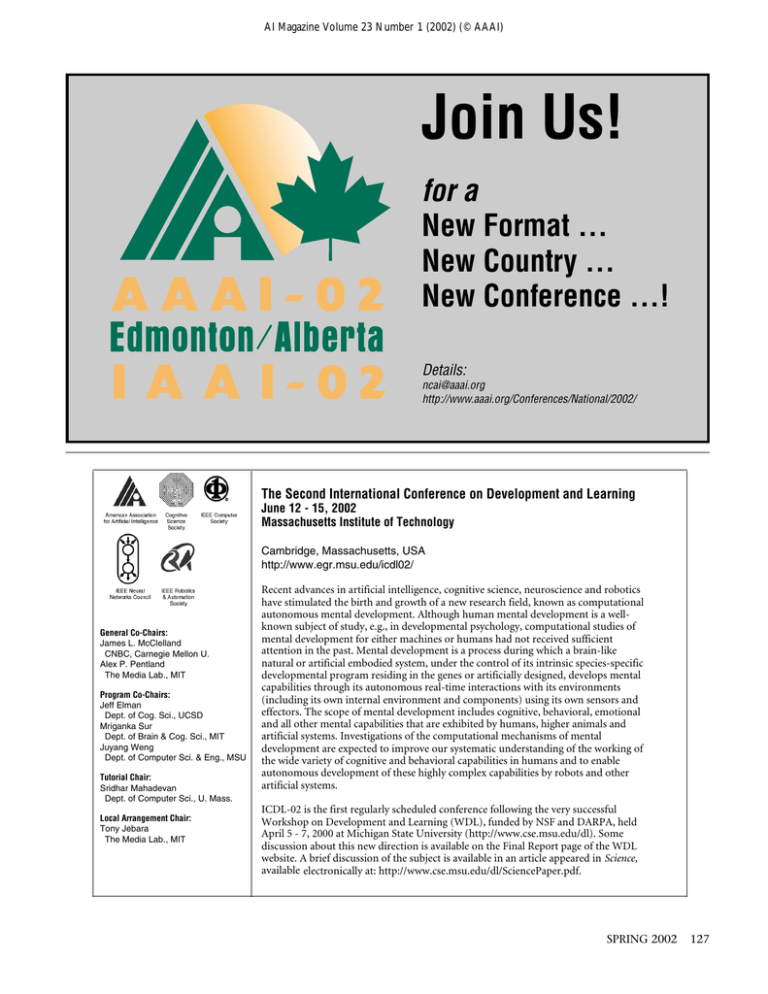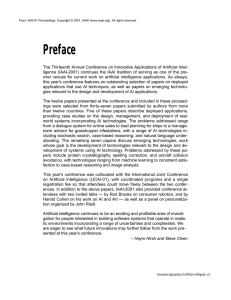
AI Magazine Volume 23 Number 1 (2002) (© AAAI)
Join Us!
for a
New Format …
New Country …
New Conference …!
Details:
ncai@aaai.org
http://www.aaai.org/Conferences/National/2002/
The Second International Conference on Development and Learning
June 12 - 15, 2002
Massachusetts Institute of Technology
Cambridge, Massachusetts, USA
http://www.egr.msu.edu/icdl02/
General Co-Chairs:
James L. McClelland
CNBC, Carnegie Mellon U.
Alex P. Pentland
The Media Lab., MIT
Program Co-Chairs:
Jeff Elman
Dept. of Cog. Sci., UCSD
Mriganka Sur
Dept. of Brain & Cog. Sci., MIT
Juyang Weng
Dept. of Computer Sci. & Eng., MSU
Tutorial Chair:
Sridhar Mahadevan
Dept. of Computer Sci., U. Mass.
Local Arrangement Chair:
Tony Jebara
The Media Lab., MIT
Recent advances in artificial intelligence, cognitive science, neuroscience and robotics
have stimulated the birth and growth of a new research field, known as computational
autonomous mental development. Although human mental development is a wellknown subject of study, e.g., in developmental psychology, computational studies of
mental development for either machines or humans had not received sufficient
attention in the past. Mental development is a process during which a brain-like
natural or artificial embodied system, under the control of its intrinsic species-specific
developmental program residing in the genes or artificially designed, develops mental
capabilities through its autonomous real-time interactions with its environments
(including its own internal environment and components) using its own sensors and
effectors. The scope of mental development includes cognitive, behavioral, emotional
and all other mental capabilities that are exhibited by humans, higher animals and
artificial systems. Investigations of the computational mechanisms of mental
development are expected to improve our systematic understanding of the working of
the wide variety of cognitive and behavioral capabilities in humans and to enable
autonomous development of these highly complex capabilities by robots and other
artificial systems.
ICDL-02 is the first regularly scheduled conference following the very successful
Workshop on Development and Learning (WDL), funded by NSF and DARPA, held
April 5 - 7, 2000 at Michigan State University (http://www.cse.msu.edu/dl). Some
discussion about this new direction is available on the Final Report page of the WDL
website. A brief discussion of the subject is available in an article appeared in Science,
available electronically at: http://www.cse.msu.edu/dl/SciencePaper.pdf.
SPRING 2002
127
Column
Man and Machine Take the Field,
David Olson, The Seattle Times (August
4, 2001). “The soccer games may be
just for fun, but the technology used
to create and operate the players could
also help build robots to rescue victims of disasters, said Hiroaki Kitano,
president of the RoboCup Federation.”
Robots Scour WTC Wreckage, Leander Kahney, Wired News (September
18, 2001). “Dozens of experimental
search-and-rescue robots are scouring
the wreckage of the World Trade Center’s collapsed twin towers.… Some of
the robots at the WTC site appeared at
this year’s annual Robocup competition, held in Seattle during the International Joint Conference on Artificial
Intelligence. The Robocup competition includes an urban search-and-rescue obstacle course.”
Intelligent Machines Will Benefit
Millions Someday, Gates Says, Brier
Dudley, The Seattle Times (August 8,
2001). “It will be at least a generation
before computers can fool people into
thinking the machines are human,
Microsoft Chairman Bill Gates predicted yesterday in his keynote speech at a
conference of artificial-intelligence researchers in Seattle.”
Artificial Intelligence: Help Wanted—AI Pioneer Minsky, Kevin Featherly. Newsbytes, a division of The
Washington Post Company (August
31, 2001). “When will computers
cease to be dumb, gussied-up adding
machines and start thinking for themselves? ‘It’s between three and 300
years,’ [Minsky] said. ‘Estimating how
long it will take is a combination of
how large we think the problems are
and how many people will work on
it.’”
Artificial Intelligence—2001: A Disappointment? The Economist (December 20, 2001). “Maybe, in the end, humans will never know the larger truth.
HAL was alien to his human crew—a
128
AI MAGAZINE
red eye, behind which lurked an unfathomable intelligence. Since 1968,
the computer has become more alien
still. Kubrick had no inkling of the
networked computer, with its potential for massively distributed intelligence. Perhaps humans will stay ignorant of the grander design, just as a
single ant has no comprehension of
the intelligence of the colony. When
2001 really does arrive, we may never
know it.”
Speech Recognition to Sort Holocaust Tapes, Kimberly Patch, Technology Research News (October 31, 2001).
“Now, after videotaping 52,000 eyewitness accounts in 57 countries and
32 languages, the [Shoah Foundation]
is looking to speech recognition software—which has also come a long
way in the past seven years—to help
with the arduous task of indexing the
116,000 hours of interviews.… CurThis eclectic keepsake will give you a sampling of what can be found (with links to the
full articles) on the AI Topics web site. Please
keep in mind that (1) the mere mention of
anything here does not imply any endorsement whatsoever; (2) the excerpt might not reflect the overall tenor of the article; (3) although the articles were initially available online and without charge, few things that good
last forever; and (4) the AI in the News collection—updated, hyperlinked, and archived—
can be found by going to www.aaai.org/
aitopics/html/current.html.
—Jon Glick, Webmaster, AI Topics
rent speech recognition software,
which works fairly well for a single
trained user, is still not up to the task
of transcribing from tape emotional
testimony from many users in many
language. The nature of this job makes
an excellent research project, however,
said [Bill] Byrne.”
Computers Try to Outthink Terrorists, Bruce V. Bigelow, The San Diego
Union-Tribune (January 13, 2002). “The
task seems daunting. More than 11.2
million trucks entered the United
States last year, according to the Customs Service. But help is at hand,
thanks to a maturing computer technology with the capability of finding
the statistical equivalent of a needle in
a haystack. Known as machine learning or neural networks, such technology uses the power of computer processing in a fundamentally different
way than conventional computers do.
Instead of a logic-oriented program
that follows a set of step-by-step instructions that lead to a definitive answer, machine learning uses statistical
modeling techniques to produce an
optimum answer. … Once known as
‘artificial intelligence’—a term that
many computer scientists disdain—
such technology now is used to detect
fraudulent financial transactions,
such as money laundering, and to
monitor industrial processes for irregularities.”
Dot-Com Crash Victims Heading
Back to College, Brenda Warner Rotzoll, Chicago Sun-Times (January 8,
2002). “The dream of dot-com riches
has turned into a nightmare for thousands of people laid off in the e-commerce bust. Many of them are coping
by going back to college to train for
different jobs—most of them still in
the computer area. They’re signing up
for subjects such as 3-D graphics, programming languages, artificial intelligence, computer networking and
game development. Some are seeking
advanced degrees but many are entering certificate programs, shorter and
less-expensive courses that in a few
months may qualify them in one specialty.”
PLEASE NOTE: Bruce Buchanan joins
Jon Glick to shine the spotlight on the
AI Topics web site itself. Their article,
“AI TOPICS: A Responsibility to Celebrate AI Responsibly,” also appears in
this issue.
Copyright © 2002, American Association for Artificial Intelligence. All rights reserved. 0738-4602-2002 / $2.00





